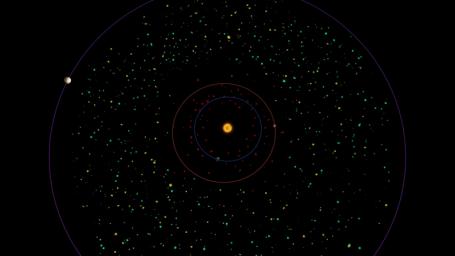
|
Asteroid Belt Bird’s Eye View
- Click the image above for a larger view
- Full-Res JPEG (1280 x 720) (51.8 kB)
- Full-Res TIFF (1280 x 720) (2.8 MB)
Caption:
This diagram shows a bird's eye view of our asteroid belt, which lies between the orbits of Mars (red) and Jupiter (purple). NASA's Wide-field Infrared Survey Explorer, or WISE, will see hundreds of thousands of asteroids with diameters larger than 3 kilometers (1.9 miles). The green dots represent populations of asteroids -- yellow illustrates the populations WISE is expected to see.
Populations of near-Earth objects -- comets and asteroids with orbits that pass relatively close to Earth's path around the sun (blue) -- are shown in red. WISE is expected to detect about 1,000 near-Earth asteroids.
Background Info:
NASA's Jet Propulsion Laboratory, Pasadena, Calif., manages the Wide-field Infrared Survey Explorer for NASA's Science Mission Directorate, Washington. The mission's principal investigator, Edward Wright, is at UCLA. The mission was competitively selected under NASA's Explorers Program managed by the Goddard Space Flight Center, Greenbelt, Md. The science instrument was built by the Space Dynamics Laboratory, Logan, Utah, and the spacecraft was built by Ball Aerospace & Technologies Corp., Boulder, Colo. Science operations and data processing take place at the Infrared Processing and Analysis Center at the California Institute of Technology in Pasadena. Caltech manages JPL for NASA.
More information is online at http://www.nasa.gov/wise and http://wise.astro.ucla.edu .
Cataloging Keywords:
| Name | Value | Additional Values |
|---|---|---|
| Target | ||
| System | Near Earth Objects | |
| Target Type | Asteroid | |
| Mission | Near-Earth Object Wide-field Infrared Survey Explorer (NEOWISE) | |
| Instrument Host | NEOWISE | |
| Host Type | Space Telescope | |
| Instrument | ||
| Detector | ||
| Extra Keywords | Color, Infrared | |
| Acquisition Date | ||
| Release Date | 2009-11-17 | |
| Date in Caption | ||
| Image Credit | NASA/JPL-Caltech | |
| Source | photojournal.jpl.nasa.gov/catalog/PIA12469 | |
| Identifier | PIA12469 | |
